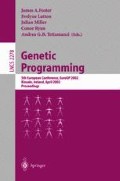Abstract
We have investigated structural distance metrics for linear genetic programs. Causal connections between changes of the genotype and changes of the phenotype form a necessary condition for analyzing structural differences between genetic programs and for the two objectives of this paper: (i) Distance information between individuals is used to control structural diversity of population individuals actively by a two-level tournament selection. (ii) Variation distance is controlled on the effective code for different genetic operators - including a mutation operator that works closely with the applied distance metric. Numerous experiments have been performed for three benchmark problems.
Access this chapter
Tax calculation will be finalised at checkout
Purchases are for personal use only
Preview
Unable to display preview. Download preview PDF.
References
Koza, J. R., Genetic Programming: On the Programming of Computers by Means of Natural Selection. Cambridge, MA, MIT Press, 1992.
Ferreira, C., 2001. Gene Expression Programming: A New Adaptive Algorithm for Solving Problems. Complex Systems, 13 (2): 87–129.
Wolfram, S., Theory and Applications of Cellular Automata. World Scientific, 1986.
Toffoli, T. and N. Margolus, Cellular Automata Machines: A New Environment for Modeling. MIT Press, 1987.
Gacs, P., G. L. Kurdyumov, and L.A. Levin, 1978. One-dimensional Uniform Arrays that Wash out Finite Islands. Problemy Peredachi Informatsii 14, 92–98 (in Russian).
Mitchell, M., An Introduction to Genetic Algorithms. MIT Press, 1996.
Koza, J. R., F. H. Bennett III, D. Andre, and M. A. Keane, Genetic Programming III:Darwinian Invention and Problem Solving. Morgan Kaufmann, San Francisco, 1999.
Juillé, H. and J. B. Pollack. Coevolving the “Ideal Trainer: Application to the Discovery of Cellular Automata Rules. In J. R. Koza, W. Banzhaf, K. Chellapilla, M. Dorigo, D. B. Fogel, M. H. Garzon, D. E. Goldberg, H. Iba, and R.L. Riolo, eds., Genetic Programming 1998: Proceedings of the Third Annual Conference, Morgan Kaufmann, San Francisco, 1998.
Holland, J. H., Adaptation in Natural and Artificial Systems: An Introductory Analysis with Applications to Biology, Control, and Artificial Intelligence. University of Michigan Press, 1975 second edition: MIT Press, 1992).
Cramer, N. L., A Representation for the Adaptive Generation of Simple Sequential Programs. In J. J. Grefenstette, ed., Proceedings of the First International Conference on Genetic Algorithms and Their Applications, Erlbaum, 1985.
Mitchell, M., J. P. Crutchfield, and P. T. Hraber, 1994. Evolving Cellular Automata to Perform Computations: Mechanisms and Impediments. Physica D 75, 361–391.
Mitchell, M., P. T. Hraber, and J. P. Crutchfield, 1993. Revisiting the Edge of Chaos:Evolving Cellular Automata to Perform Computations. Complex Systems 7, 89–130.
Das, R., M. Mitchell, and J. P. Crutchfield, A Genetic Algorithm Discovers Particle-based Computation in Cellular Automata. In Y. Davidor, H.-P. Schwefel, and R. Männer, eds., Parallel Problem Solving from Nature-PPSN III, Springer-Verlag, 1994.
Dawkins, R., River out of Eden. Weidenfeld and Nicolson, 1995.
Author information
Authors and Affiliations
Editor information
Editors and Affiliations
Rights and permissions
Copyright information
© 2002 Springer-Verlag Berlin Heidelberg
About this paper
Cite this paper
Brameier, M., Banzhaf, W. (2002). Explicit Control of Diversity and Effective Variation Distance in Linear Genetic Programming. In: Foster, J.A., Lutton, E., Miller, J., Ryan, C., Tettamanzi, A. (eds) Genetic Programming. EuroGP 2002. Lecture Notes in Computer Science, vol 2278. Springer, Berlin, Heidelberg. https://doi.org/10.1007/3-540-45984-7_4
Download citation
DOI: https://doi.org/10.1007/3-540-45984-7_4
Published:
Publisher Name: Springer, Berlin, Heidelberg
Print ISBN: 978-3-540-43378-1
Online ISBN: 978-3-540-45984-2
eBook Packages: Springer Book Archive

